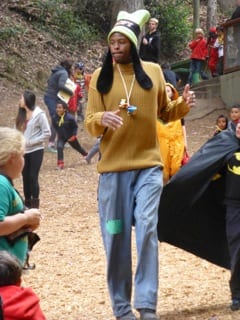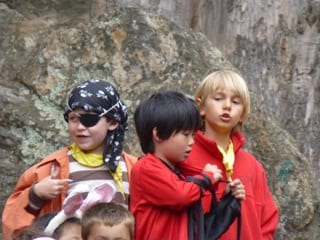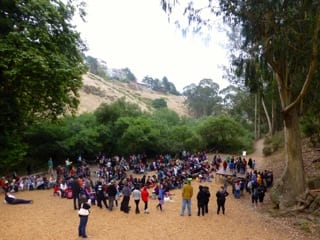
To celebrate the Glen Park Association Website turning ten years old, we are reposting some of our favorite stories from the last ten years.
As Silver Tree Day Camp prepares to conclude its seventy-third summer in Glen Canyon, visitors over the past few years have noticed that many things have changed . . .and yet it’s still the same camp hundreds of children look forward to every year.
The day camp, operated by the San Francisco Recreation and Parks Department, runs for 11 weeks each summer and offers a variety of activities for children ages 6 to 11 in an outdoor setting so awe inspiring that some say it rivals the national parks. Its name comes from the silvery leaves of the eucalyptus trees that surround the building where the camp is held deep in Glen Canyon Park.
From the mysterious Dead Man’s Cave to the ominous (or culinary) Giant’s Chopping Block, the oasis offers city kids an opportunity to partake in activities that children in other cities must travel miles away from home to experience. And at under $200 a week ($133 for San Francisco residents, $190 for non-residents), from Monday to Friday, parents see it as a gift as well.

Averaging 190 children per week, each day is packed with activities including hikes, games, arts and crafts, flag making, campfire safety lessons, storytelling, nature activities and education. There’s also the iconic Thursday night campfires, which includes roasting marshmallows and hot dogs, singing songs and skits performed for parents and guests.
Over the decades, campers grow up. But for some, Silver Tree holds such a special place in their hearts that they now send their children there. They will find some changes from the camp they knew, but the important parts stay the same.
Once Silver Tree employed three cooks who prepared hot lunches and snacks for campers, junior counselors (JCs) and counselors every day except Thursday, which was (and remains) campfire night.
Teresa McGarvey Vieira, who now lives on the East Coast, admits that when she is struggling to come up with a dinner plan, she sometimes resorts to the old camp menu.

Asked about camp, Vieira said “Remember it? I DREAM about it.” She was a camper and JC in the 1980s.
Mondays included franks and beans (beanie weenies, as they called it); Tuesday, beef stew over rice, Wednesday was Sloppy Joes, and on Fridays camp served up spaghetti. Each meal included salad, bread and butter, fruit and chocolate or white milk.
Mary Blevins, who attended in the 1980s and early 1990s, said, “I don’t know why, but those sides of bread and butter with the meals three times a week were THE best bread and butter ever!”
Blevins added, “Oh, what I wouldn’t give to have that beef stew or spaghetti again!”
In terms of snacks, Monday was cake day, Tuesdays, butter cookies, Wednesdays, watermelon, Thursdays, peanut butter and jelly sandwiches with hot chocolate and Friday, Eskimo Pies. Except for Thursdays, each snack was accompanied by juice, which campers and counselors alike called “bug juice.”
The hot lunches ended in the late 1980s because of budget cuts. Today campers are asked to bring a bag lunch and bottle of water.
The weekly Wednesday trips to the San Francisco Zoo have also come and gone, but most traditions live on. Earlier in the year, there were whisperings of the camp ending the Nature Hunt (Bug Hunt), campfire program and telling of camp legends during hikes, but Donna DeTurris, Cultural Arts Supervisor, said those claims are unfounded.
“Campfires, bug hunts and legends were never considered for removal from Silver Tree Camp programs,” DeTurris said. “These are traditional programs, which both the campers and staff enjoy and will continue to be a cornerstone for this camp.”
Miles Ford, whose son Ethan, aged 6, attends Silver Tree, is glad to hear the legends will remain. “Legend is another word for ‘story’ and it encourages kids’ imagination.”
Ford, who is from Bristol, England, added that they didn’t have camps like this where he grew up. “We just ran riot over the countryside.”
Kim and Pete Young, whose children Sirisvati, 10, and Atticus, 8, attended this year, are also pleased to hear the legends are staying. While some have criticized the legends as violent, Pete said, “Kids see a lot worse on TV and video games.”
Sirisvati, who does not particularly enjoy the hikes through the canyon for the telling of the camp legends, said she enjoys camp overall. “It’s definitely fun to be with your friends, play kickball, sing songs and do skits,” she said.
Sarah McNitt, who was waiting for her son to perform in a skit on a recent Thursday, said the legends are “dark, scary and classic. Kids dig it.”
Nikki Hampton Ellis, who attended as a camper and then JC, now sends her daughters to camp.
“It’s not the same,” she said. “My kids love going, but I’m not seeing the same level of attachment to camp that we had when we were young. I think the city itself has changed so much that it’s somewhat expected that camp would change as well, but it’s disappointing that there’s no more small camp feel where everyone knows everyone else the way it used to be. Kids aren’t hard core into their camp color anymore. There used to be some serious rivalries between colors.”
Ellis said Alyssa, 11, “enjoys the dirt and sports. She likes getting dirty.” Madison, 6, “loves the marshmallows. Seriously. That’s what she said.”
During the Thursday night campfire programs, campers in 10 camps (which increased from six) still roast hot dogs (turkey or veggie) and marshmallows, sing the traditional songs and perform the familiar skits. Yes, they still perform “Egg Shampoo.”
Colored camps now include: Red, Pink, Dark and Light Green, Dark and Light Blue, Gold, Purple, Brown and Orange.
DeTurris said, “Organization of campers in smaller groups would provide a more intimate experience, a safer environment for each camper, and easier transitions from campers moving from one activity to another. Having 10 camp colors allows for the capacity of 18 to 22 campers per group with one Junior Counselor and one Camp Counselor providing supervision.”
She added, “The Gold, Orange, and Pink color groups are designated for 5-7 years old campers. This keeps the younger kids in an environment that is considered both age appropriate and safe.”
Another change is that the former Green and Brown campsites are no longer used because of concerns for fire safety.
“Before the start of Silver Tree Camp, the camp supervisor and camp managers met with the SF Fire Department’s certified state fire training instructor. With SFFD’s help we identified that Green and Brown camps’ pits were no longer safe to use,” DeTurris said.
“This is largely due to the shrub growth, fire pit depths, and certain trees being too close to the fire pits. Once again, this is a very large camp and the safety of our campers and staff is our first priority. As a result, we have chosen not to use these specific locations and are planning to install prefabricated fire pits as a safety measure.”
Unlike several years ago, Thursday night campfire programs now have themes such as costume, pot luck and carnival night. On carnival night, campers forgo the songs and skits for games where campers can dunk JCs, jump in bouncy houses and take home a pet goldfish.
Costume Night featured ninjas, cowboys, witches, Spider-Man (and Spider-Woman!), butterflies, devils, wolves, Little Red Riding Hood, Scarlett O’Hara and a bunny, who dressed appropriately for her camp signing “Little Bunny Foo Foo.”
On Potluck Night, parents brought tables full of food from salads to intricate desserts. Campers, JCs, counselors and guests filled their tummies and then gathered at Main Camp for songs and skits.
Wayne Larson, whose 10-year-old son Benjamin was proud to say he was a Brown Camper, is gladdened to see that although there have been changes to the campfire program, it essentially will remain the same.
“Tradition is a big plus,” Larson said. “It’d be sad to do away with the campfire tradition.”
Sirisvati agrees. “A lot of kids haven’t gone camping so they haven’t roasted hot dogs and marshmallows before,” said the Light Blue Camper.
The Nature/Bug Hunt, which used to take place on Monday afternoons and Tuesday mornings, has also seen some changes in an effort to preserve the canyon’s insect inhabitants.
“It is SF Rec and Park’s mission to preserve and respect our natural environment. The Bug Hunt in the past allowed (180) campers to remove as many bugs as they could in order to win the bug contest. This might not seem significant; however, when you multiply this number by 11 weeks it does directly impact the local ecosystem,” said DeTurris.
“Silver Tree Camp’s goal is not to eliminate any traditional activity, but to enhance what already exists, therefore, this year we are committed to educating our campers on how to have fun while respecting our parks and natural resources. As an improvement, we are limiting the number of bugs collected.”
Ellis understands that change is part of life and accepts it, but is glad some traditions at Silver Tree remain.
“If they did away with these things (legends, nature hunts, campfire program) it would be unfortunate. So much of what makes Silver Tree great is tradition and sharing those traditions with your kids. My kids are third generation campers. My mom and her siblings attended camp; my sister, Jamie, and I went and now my girls go. Being able to share the same stories, songs, and activities from one generation to the next is part of the charm of Silver Tree and Glen Park. I’d be really disappointed if those things went away.
Tradition is important when it comes to camp and seems to be a reason why alumni now send their kids there.
Ellis said, “I send them to camp because Silver Tree was so much a part of my childhood. I looked forward to summer all year because the best stuff happened during the summer. I had my first real adventures, first job and first real boyfriend all happen during the summer at Silver Tree. I want my kids to have that same connection. We love to talk about the similarities and differences between my experience and theirs.”
At Silver Tree, there is something for everyone.
Alyssa said, “I like how it involves nature, and has kid-friendly activities that are fun and not just boring stuff.”
Madison said, “I liked everything except kickball, especially arts and crafts, and lanyards.”
Along with some changes, there are additions to the Silver Tree program, including archery, flag making and base camp, where campers learn proper fire preparation and safety.
Kids and their parents are excited about archery, a new addition to Silver Tree although it has been part of the SF Park and Recreation program for years.
McNitt’s 8-year-old son Donovan, a Dark Green Camper, is “psyched about archery,” but still, his favorite part of camp is the campfire program.
Sirisvati sounded like an expert already as she explained the different types and sizes of bows, what to do and what not to do. “It’s really fun,” she said.
Other subtle changes include renaming “Quiet Hour,” a period after lunch where campers sing songs, to “TnT.”
“Changing the name from Quiet Hour to TnT (a.k.a Thursday Night Theatre practice) helps clarify the activities that are included during this specific time to new campers, parents, and staff,” DeTurris said.
DeTurris also added that “Silver Tree Camp now provides both recycling bins and compost bins to educate staff and campers on how to be better stewards of our natural environment. In addition, we have SF Police Department volunteer their time playing with Silver Tree campers that enrich the campers’ experience.”
In the future, DeTurris said they plan “more on improved care for the well-being of our campers, [such as] lice checks implemented into Monday morning procedures. All Silver Tree staff has been trained on how to identify head lice. It is part of our preventive efforts on the possible spread of head lice during the summer months of camp.”
The camp also offers extended care until 6 pm Mondays, Tuesdays, Wednesdays and Fridays and 8 am to 1pm on Thursdays.
The construction in Glen Park, which has closed off the main entrance to the park on Alms Road, has not hindered the camp program in any way, DeTurris said. However, “construction and closure to the Recreation Hall has made pre-care and after-care remain back at camp. A subtle yet necessary change to keep campers engaged in fun and safe activities.”
With so many planned activities, some parents are concerned about the lack of free time and do not necessarily like their children’s summers to be so structured.
Pete Young said, “Kids’ whole lives are structured from pre-school til they die.”
His wife, Kim, concurs and said she is “less of a fan of the structured activities. Outside, kids should be more free and imaginative.”
Explaining the camp planned activities, DeTurris said, “The new and improved Silver Tree Camp offers safe and age appropriate activities that each day there is ample time where campers engage in free play of their choice. The campers can decide between three different activities agreed upon by each camp counselor and campers. In addition, camp counselors are allowed the flexibility to modify and adapt all activities based on the needs, abilities and desires of their campers.”
While Silver Tree has seen many changes over the years, the tradition of a day camp in the City remains strong. Although tested by time and budget cuts, it still serves as a “nature oasis in an urban desert,” as Kim Young called it.
“There is nowhere else I can think of where city kids can (for a very reasonable price) roll in the dirt, play kickball, ultimate Frisbee, whiffle ball, ping pong, scavenge for bugs, learn to roast the perfect marshmallow, go for hikes, hunt for Junior Counselors and learn to make lanyards all in one place,” Ellis said.
Sitting on a weather beaten log waiting for his son to sing “Greasy, Grimy Gopher Guts” with his camp, Pete Young said this, “It’s low key, not fancy. It’s simple and sweet—just as summer should be.”